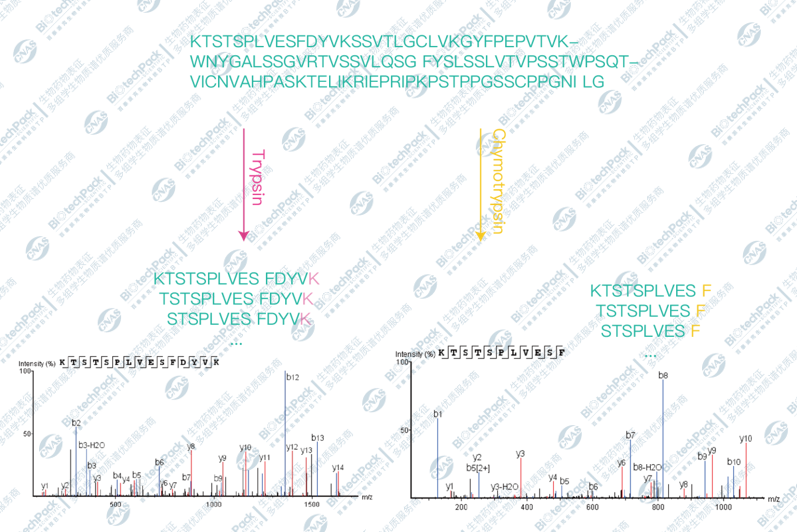Mass Spectrometry N-terminal Sequence Analysis
Mass spectrometry-based N-terminal sequence analysis is a method that uses mass spectrometry technology to efficiently and accurately determine the amino acid sequence at the N-terminus of proteins/peptides. Due to its high sensitivity, high resolution, and high throughput, it can be used to analyze complex protein/peptide mixtures and identify modifications, mutations, and other sequence variations. Compared to traditional Edman degradation, mass spectrometry offers higher throughput and sensitivity, enabling the analysis of more complex samples and larger proteins.
Based on high-resolution mass spectrometry N-terminal sequencing, after separating the target protein using SDS-PAGE, the sample is digested with proteases. The digested product is analyzed using a Q-Exactive series mass spectrometer (Thermo Fisher Scientific). The peptide fragments are fragmented in the mass spectrometer to obtain b and y ion tandem mass spectra. The spectra are compared with the theoretical amino acid sequence of the protein to determine the N-terminal position. Biotech company BTP combines high-performance liquid chromatography and high-resolution mass spectrometry to establish a mass spectrometry-based N-terminal sequence analysis platform based on N-terminal sequencing principles. BTP is certified by CNAS/ISO9001 dual quality management systems, providing high-quality mass spectrometry N-terminal sequence analysis services. We employ two different protease cleavage methods to produce two N-terminal peptides of different lengths, mutually verifying to ultimately determine the protein N-terminal sequence.Welcome to consult for free to learn more details!

Comparison of two enzyme cleavage methods for mass spectrometry-based N-terminal sequence analysis
Experimental Instruments
- High-performance liquid chromatography tandem mass spectrometer: High-performance liquid chromatography - Easy-nLC 1200
- Electrospray-Combined Ion Trap Orbitrap Mass Spectrometer - Q Exactive™ Hybrid
Quadrupole-Orbitrap™ Mass Spectrometer

Technical Advantages
- Based on high-resolution mass spectrometry N-terminal sequencing, it is possible to analyze N-terminal blockage and post-translational modifications (PTMs) through high-resolution mass spectrometry, thereby determining the starting point of protein N-terminus;
- For complex proteins, our company supports N-terminal dimethylation labeling of complex proteins. By analyzing the labeling position, the N-terminal starting points of multiple proteins in complex protein samples can be determined.
Case Illustration
N-terminal amino acid sequence analysis of protein drug samples:
After Trypsin digestion, the sample is analyzed by LC-MS/MS to obtain mass spectrometry data. The mass spectrometry data is matched with the theoretical database, resulting in an MS2 spectrum that matches the theoretical N-terminal sequence (HYAHVDCPGHADYVK). The spectrum is as follows:

N-terminal sequence MS/MS spectrum
From the above analysis, it can be concluded that the starting amino acid of this protein drug is histidine, with the N-terminal sequence HYAHVDCPGHADYVK.
Chinese/English Project Report
In the technical report, BTP will provide you with a detailed bilingual technical report in Chinese and English, including:
1. Experimental procedures (in Chinese and English)
2. Related mass spectrometry parameters (in Chinese and English)
3. Detailed information on mass spectrometry-based N-terminal sequence analysis
4. Mass spectrometry images
5. Raw data
Mass Spectrometry N-terminal Sequence Analysis OneStop Service
You only need to place an order and send the sample
BTP One-stop Service includes: sample processing - on-machine analysis - data analysis - project report
Related Services
N-terminal sequencing based on Edman degradation
Protein N/C-terminal sequencing
Sequence analysis based on mass spectrometry
Protein sequencing based on mass spectrometry
Antibody sequencing based on mass spectrometry
Peptide sequencing based on mass spectrometry
N-terminal sequencing based on Edman degradation
Protein sequencing based on Top-down approach
How to order?





